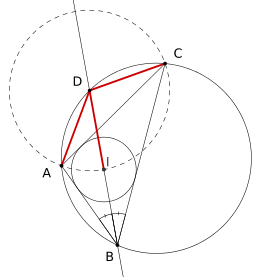Trillium theorem
In Euclidean geometry, the trillium theorem – (from Russian: лемма о трезубце,[1][2] literally 'lemma about trident', Russian: теорема трилистника,[3] literally 'theorem of trillium' or 'theorem of trefoil') is a statement about properties of inscribed and circumscribed circles and their relations.
Theorem

Let ABC be an arbitrary triangle. Let I be its incenter and let D be the point where line BI (the angle bisector of ∠ABC) crosses the circumcircle of ABC. Then, the theorem states that D is equidistant from A, C, and I. Equivalently:
- The circle through A, C, and I has its center at D. In particular, this implies that the center of this circle lies on the circumcircle.[4][5]
- The three triangles AID, CID, and ACD are isosceles, with D as their apex.
A fourth point, the excenter of ABC relative to B, also lies at the same distance from D, diametrally opposite from I.[2][6]
Application to triangle reconstruction
This theorem can be used to reconstruct a triangle starting from the locations only of one vertex, the incenter, and the circumcenter of the triangle. For, let B be the given vertex, I be the incenter, and O be the circumcenter. This information allows the successive construction of:
- the circumcircle of the given triangle, as the circle with center O and radius OB,
- point D as the intersection of the circumcircle with line BI,
- the circle of the ò theorem, with center D and radius DI, and
- vertices A and C as the intersection points of the two circles.[7]
However, for some triples of points B, I, and O, this construction may fail, either because line IB is tangent to the circumcircle or because the two circles do not have two crossing points. It may also produce a triangle for which the given point I is an excenter rather than the incenter. In these cases, there can be no triangle having B as vertex, I as incenter, and O as circumcenter.[8]
Other triangle reconstruction problems, such as the reconstruction of a triangle from a vertex, incenter, and center of its nine-point circle, can be solved by reducing the problem to the case of a vertex, incenter, and circumcenter.[8]
Generalization
Let I and J be any two of the four points given by the incenter and the three excenters of a triangle ABC. Then I and J are collinear with one of the three triangle vertices. The circle with IJ as diameter passes through the other two vertices and is centered on the circumcircle of ABC. When one of I or J is the incenter, this is the trillium theorem, with line IJ as the (internal) angle bisector of one of the triangle's angles. However, it is also true when I and J are both excenters; in this case, line IJ is the external angle bisector of one of the triangle's angles.[9]
See also
References
- Р. Н. Карасёв; В. Л. Дольников; И. И. Богданов; А. В. Акопян. Задачи для школьного математического кружка (PDF). Problem 1.2. p. 4.CS1 maint: location (link)
- "6. Лемма о трезубце" (PDF). СУНЦ МГУ им. М. В. Ломоносова - школа им. А.Н. Колмогорова. 2014-10-29.
- И. А. Кушнир. "Это открытие - золотой ключ Леонарда Эйлера" (PDF). Ф7 (Теорема трилистника), page 34; proof on page 36. Cite journal requires
|journal=(help)CS1 maint: location (link) - Morris, Richard (1928), "Circles through notable points of the triangle", The Mathematics Teacher, 21 (2): 63–71, JSTOR 27951001. See in particular the discussion on p. 65 of circles BIC, CIA, AIB, and their centers.
- Bogomolny, Alexander, "A Property of Circle Through the Incenter", Cut-the-Knot, retrieved 2016-01-26.
- Bogomolny, Alexander, "Midpoints of the Lines Joining In- and Excenters", Cut-the-Knot, retrieved 2016-01-26.
- Aref, M. N.; Wernick, William (1968), Problems and Solutions in Euclidean Geometry, Dover Books on Mathematics, Dover Publications, Inc., 3.3(i), p. 68, ISBN 9780486477206.
- Yiu, Paul (2012), "Conic construction of a triangle from its incenter, nine-point center, and a vertex" (PDF), Journal for Geometry and Graphics, 16 (2): 171–183, MR 3088369
- Chou, Shang-Ching; Gao, Xiao-Shan; Zhang, Jingzhong (1994), Machine Proofs in Geometry: Automated Production of Readable Proofs for Geometry Theorems, Series on applied mathematics, 6, World Scientific, Examples 6.145 and 6.146, pp. 328–329, ISBN 9789810215842.